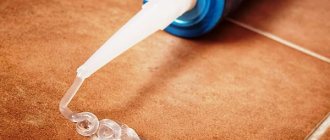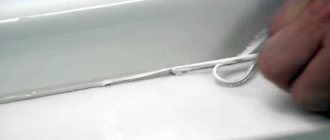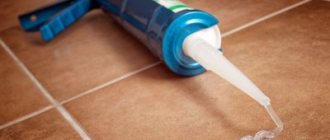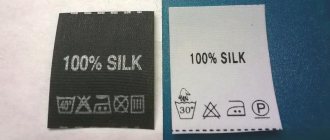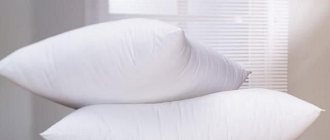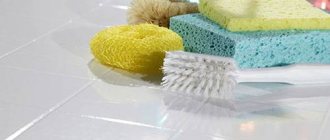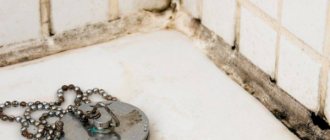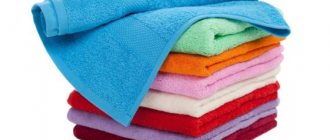Home page » Home and comfort » Cleaning
Author of the article
Svetlana Pavlikhina
Reading time: 5 minutes
AA
After renovation, traces of finishing materials or glue remain in the kitchen or bathroom. Removing sealant from tiles is a difficult task. It is better to wipe off the substance immediately, without waiting for it to harden.
Dried silicone glue firmly eats into the glossy surface of ceramics or glass. It is important to choose cleaning methods that will not damage the tiles and will clean them quickly and effectively.
Purpose of the sealant
This is a plastic material that has a high degree of elongation and has high waterproofing properties. It is necessary for sealing seams and joints, after which liquid will not get under them.
The substance provides reliable waterproofing between the floor and the toilet, wall and sink. The sealant quickly sets, adheres to surfaces, and hardens.
Also, a plastic substance is necessary to seal the joints between tiles and a bathtub or kitchen sink.
It is applied in a thin layer, filling the seam. Use sealant to eliminate gaps in the bathroom and kitchen.
Fast curing is a good characteristic for a sealant, but not when it needs to be removed from the tile surface. This task is a real problem, especially if the substance has hardened and dried out.
Precautionary measures
Substances designed to remove layers from the surface are toxic, for this reason compliance with safety regulations is required. The master must wear rubber gloves, a respirator, and closed clothing. The room is provided with high-quality ventilation.
To prevent substances from getting onto the tiled surface, it is recommended to stick masking tape along the border. If you choose the composition in a can, then it is sprayed with extreme care; it is too easy to get into an unnecessary area, so most of the nearest surface is covered. After removing the material, the chemical composition is washed so that it does not remain on the tiles.
To prevent substances from getting onto the tiled surface, it is recommended to stick masking tape along the border.
Methods for removing sealant
The sealant can be dissolved or scraped off. During the work process, chemical and mechanical methods are used.
Their combination gives reliable and fast results.
Mechanical impact
This method is used for frozen, dried substances. Immediately after application it is almost transparent and difficult to detect.
After a few hours, the composition hardens and turns white, and it becomes clear that the joints and seams need to be leveled, and whitish splashes and stains must be removed in some places.
The sealant is scraped off the ceramic surface with a knife, blade, scraper, or spatula.
The procedure is carried out carefully, trying not to scratch the tile.
It is convenient to take a razor blade for these purposes. Its sharp end penetrates well under the silicone layer, separating it from the tile. The cut is carried out clearly, in one movement, removing excess sealant. It is important not to injure your hands in the process.
If the sealant is firmly embedded in the tile, it is better to leave a small amount of it. Do not press the blade too hard, as this can ruin the smooth surface of the tile.
After construction work, it is recommended to immediately wash the sealant without waiting for it to harden. This can be done using soapy water and a kitchen sponge.
Chemical exposure
The method involves removing the adhesive substance with a solvent or white spirit.
These compounds act on dried sealant, softening it.
Material characteristics
Main characteristics of silicone sealant.
- Used to seal seams and create a movable joint. Given the elasticity of the material, the integrity of the seam will not be compromised.
- Can be used at temperatures from – 50 to + 200-300 degrees.
- Used in different conditions, aggressive substances are used.
- Has increased moisture resistance after complete drying.
- Characterized by high adhesion to many materials.
- Seams and joints coated with silicone are not exposed to fungi and mold.
Despite the large number of positive properties, the material also has several disadvantages:
- It is quite difficult to treat dry surfaces;
- Reliable sealing is not always achieved on some surfaces such as polyethylene, polycarbonate, fluoroplastic.
Silicone sealant is used not only in home construction, but also for industrial purposes. Professional sealants do not have such disadvantages: they consist of various fillers and components. At the same time they have a high price.
Sealants can have different properties, colors and be used in different areas. They are divided into two categories: one-component and two-component.
Single-component sealants are used in everyday life and home repairs. This material is immediately ready for use: it is not mixed. They sell it in tubes and file packages, which is very convenient to use. Once the sealant comes into contact with air, it hardens.
Sealants can also be divided into acidic, alkaline and neutral. Acid sealants should not be used on metal surfaces, as the acetic acid present in the composition will promote corrosion of the metal. Such sealants are marked with the letter “A” and are inexpensive.
Neutral sealant can withstand very high temperatures: up to +300 degrees, so it is often used when arranging a bathhouse or sauna. Has a high price.
What tools will be useful
To mechanically remove the sealant, take a narrow construction spatula or scraper; a razor blade, a construction knife, a stationery knife, or an eraser can also be useful.
In the bathroom, the sealant is cleaned off especially carefully so as not to damage the bathtub. Be especially careful when removing the silicone layer from the acrylic surface.
Construction spatula
The tool is easy to use. It has a wide handle that is comfortable to hold.
Construction scraper
The device is chosen with a sharp blade. It will help to quickly remove any remaining adhesive without damaging the fragile surface of the tile.
razor blade
This is a simple tool that can be found in every home. It will help deal with dried sealant. Disadvantages: it is inconvenient to manipulate the small blade, it is easy to cut your hands.
Advantages: a small sharp object penetrates even the most inaccessible places and quickly cuts off small drops of silicone.
Shoe knife
This scraper is used to cut off a thin layer of adhesive substance. Its remains are cleaned with salt, then washed off with a rag soaked in a soap solution.
Special tool
Construction stores sell sets of knives for removing sealant.
They are equipped with universal nozzles of various shapes, suitable for any angles and surfaces. Using this device, the old layer of adhesive is removed and fresh waterproofing is applied.
Screwdriver
It can penetrate into any hard-to-reach corners of the kitchen and bathroom. Operate the device carefully, without pressure. Residues of silicone are removed with any suitable solvent.
The mechanical cleaning method is labor-intensive and unreliable; it is used in special cases when solvents or special cleaning agents cannot be used.
Fresh and old
Of course, it is easiest to remove fresh dirt. Silicone is quite noticeable on tiles, so if you make a careless movement that leads to silicone contamination of the tiles, the sealant must be removed immediately. For this, a dry rag is suitable, which you need to “collect” the silicone. Old stains are more difficult to deal with and the composition will be erased only after applying effort.
